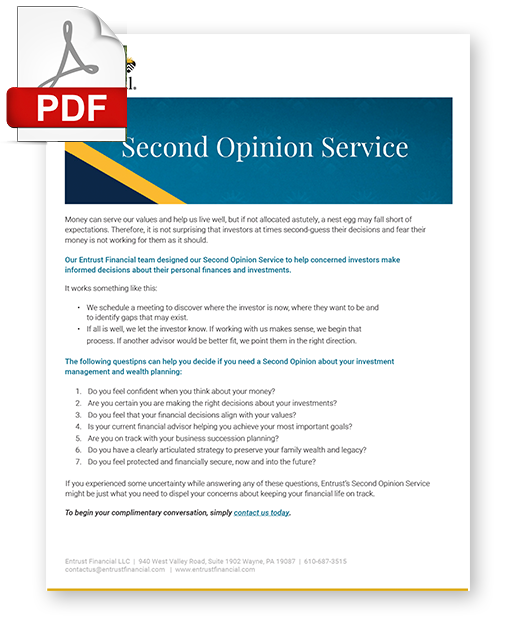A Fantastic Retirement Is Not Just About Your Portfolio: 3 Tips You Need to Know Now

Preparing for retirement is often identified as the number one concern of middle-class millionaires. The implied solution for resolving this concern is rather straightforward: Build a portfolio large enough to generate the income you need for the style of living you prefer, and you are good to go. After all, having a good income during your working years made all the difference. Won’t it be the same in retirement?
Well, maybe, but then again maybe not—due to what we, at Entrust, like to call the “longevity wild card.” This retirement wild card is: Being prepared to pay for health-related expenses that can surface as you age, especially those not covered by Medicare or your supplemental health insurance. These costs can be unpredictable and large.
What to do? Our 3 Tips You Need to Know Now can help you be prepared for unpredictable longevity expenses, without tapping into your retirement portfolio. We feel certain these Tips will prompt your thinking, so now is the perfect time to contact Entrust to start a conversation about how you can restore “Fantastic” to your retirement planning. Contact us at info@entrustfinancial.com or call us 610.687.3515.
Click on each Tip to learn how to help prevent the longevity wild card from hurting you or your family in retirement:
Tip #1: Insure
Tip #2: Consider a CCRC
Tip #3: Pay as you go
Tip #1: Insure
 When conducting our annual portfolio review with Jim and Linda, the subject of paying for health-related expenses after they retired came up in conversation. They had always promised themselves they would never be a financial burden to their two children, but realized that, to date, they had avoided taking action to prevent this eventuality. Our discussion segued into the pros and cons of long-term care insurance, as a solution to unexpected health-related expenses they might confront in retirement. Long-term-care insurance is an insurance product that provides for the cost of long-term care for a predetermined period of time. It covers the cost of care generally not covered by health insurance such as Medicare, or Medicaid. Annual premiums payment are typically required to keep the insurance in force.¹ Although Jim and Linda reported that some of their friends argue against the need for insurance due to the cost of the annual premiums, when we compared this cost to just one month of even the most basic assisted living help—at home or in a care center—they decided that the premiums did not seem so high after all.
When conducting our annual portfolio review with Jim and Linda, the subject of paying for health-related expenses after they retired came up in conversation. They had always promised themselves they would never be a financial burden to their two children, but realized that, to date, they had avoided taking action to prevent this eventuality. Our discussion segued into the pros and cons of long-term care insurance, as a solution to unexpected health-related expenses they might confront in retirement. Long-term-care insurance is an insurance product that provides for the cost of long-term care for a predetermined period of time. It covers the cost of care generally not covered by health insurance such as Medicare, or Medicaid. Annual premiums payment are typically required to keep the insurance in force.¹ Although Jim and Linda reported that some of their friends argue against the need for insurance due to the cost of the annual premiums, when we compared this cost to just one month of even the most basic assisted living help—at home or in a care center—they decided that the premiums did not seem so high after all.
¹Balancing Act: Wealth Management Straight Talk for Women, Joslyn G. Ewart, 2016, p.112, Chapter 6: Delineate a Retirement Plan
Tip #2: Consider a CCRC
 A conversation that began with consideration of the purchase of long-term care insurance, as part of their retirement preparation, took a surprising detour during a recent meeting with clients Dan and Grace. They indicated that even if a long-term care insurance policy paid for large, unexpected health-related expenses, they would still feel worried about what the future held.
A conversation that began with consideration of the purchase of long-term care insurance, as part of their retirement preparation, took a surprising detour during a recent meeting with clients Dan and Grace. They indicated that even if a long-term care insurance policy paid for large, unexpected health-related expenses, they would still feel worried about what the future held.
Dan and Grace wanted to ensure not only that their retirement economics would be in good shape, but also that they could choose—while healthy—where care (if needed) would be provided to them; they wanted to know more about CCRC’s.
CCRC’s (Continuing Care Retirement Community) are retirement communities designed to meet a number of elder-care needs within a single residential or community campus. A variety of health care needs are met by providing different living options, including independent living, assisted living, and skilled nursing care.
Two pricing options may be available: 1) Pay for what you need model; 2) Level pay as you go model.¹
Ultimately, Dan and Grace decided they liked the certainty of the CCRC “level pay as you go” model. This permitted them to map out their expenses more precisely before taking action. And they liked knowing that upon moving to a CCRC, the community would continue to assist—even if their personal funds someday ran short.
You may wish to learn more by joining us for our three-part series of presentations regarding the benefits of the CCRC lifestyle.
¹Balancing Act: Wealth Management Straight Talk for Women, Joslyn G. Ewart, 2016, p.112, Chapter 6: Delineate a Retirement Plan
Tip #3: Pay as you go
 Jenny and Wanda have always been diligent savers. They value their financial independence and one of their stated retirement goals is “to have lifelong financial freedom.” The issue of funding potential long-term care costs in retirement was on our annual review meeting agenda when we met last month.
Jenny and Wanda have always been diligent savers. They value their financial independence and one of their stated retirement goals is “to have lifelong financial freedom.” The issue of funding potential long-term care costs in retirement was on our annual review meeting agenda when we met last month.
Following a review of the benefits of choosing to purchase long-term care insurance, or to consider selecting a CCRC at some point, both women decided that they preferred to earmark a portion of their savings as their “health care fund”—separate from their designated retirement portfolios. They recognize that this choice carries with it more personal financial risk than the other options for preparing for unexpected health-related expenses in the future.












